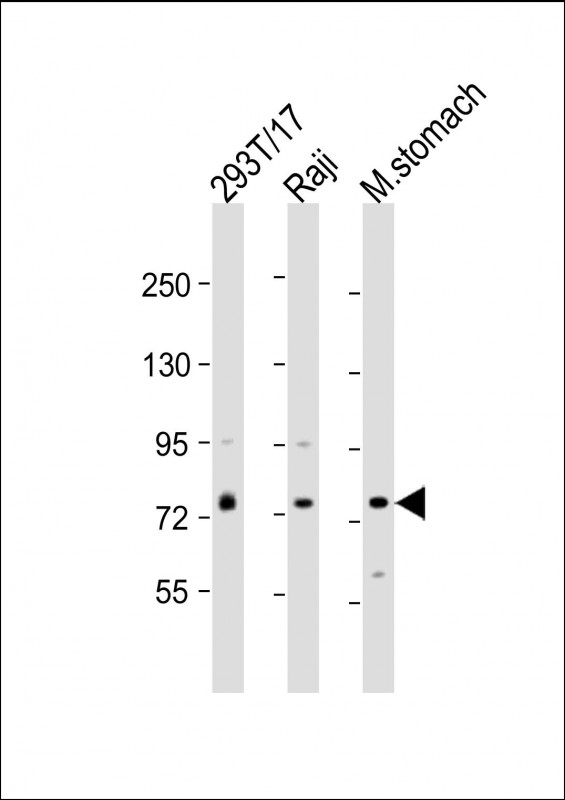
| WB | 1/2000 | Human,Mouse,Rat |
| IF | 咨询技术 | Human,Mouse,Rat |
| IHC | 咨询技术 | Human,Mouse,Rat |
| ICC | 技术咨询 | Human,Mouse,Rat |
| FCM | 咨询技术 | Human,Mouse,Rat |
| Elisa | 咨询技术 | Human,Mouse,Rat |
| Aliases | Cytosolic phospholipase A2 zeta, cPLA2-zeta, 3.1.1.4, Phospholipase A2 group IVF, PLA2G4F |
| Entrez GeneID | 255189 |
| WB Predicted band size | 95.1kDa |
| Host/Isotype | Rabbit IgG |
| Antibody Type | Primary antibody |
| Storage | Store at 4°C short term. Aliquot and store at -20°C long term. Avoid freeze/thaw cycles. |
| Species Reactivity | Human, Mouse |
| Immunogen | This PLA2G4F antibody is generated from a rabbit immunized with a KLH conjugated synthetic peptide between 289-331 amino acids from the Central region of human PLA2G4F. |
+ +
以下是关于PLA2G4F抗体的示例参考文献(仅供参考,建议通过学术数据库验证具体信息):
---
1. **Title**: *Characterization of PLA2G4F-Specific Antibodies and Their Role in Lipid Metabolism Studies*
**Authors**: Tanaka, K., et al.
**Summary**: 本研究开发了针对PLA2G4F的高特异性单克隆抗体,验证了其在Western blot和免疫组化中的应用。研究发现PLA2G4F在结肠癌组织中表达上调,可能通过调控花生四烯酸代谢促进肿瘤发展。
2. **Title**: *PLA2G4F as a Potential Biomarker in Inflammatory Diseases: Insights from Antibody-Based Detection*
**Authors**: Smith, R.J., & Patel, H.
**Summary**: 通过抗体验证,发现PLA2G4F在类风湿性关节炎患者的滑膜液中显著升高,提示其可能参与炎症信号通路。研究强调了该抗体在疾病诊断中的潜在价值。
3. **Title**: *Structural and Functional Analysis of PLA2G4F Using Polyclonal Antibodies*
**Authors**: Chen, L., et al.
**Summary**: 利用兔源多克隆抗体解析PLA2G4F的酶活性位点,证实其与特定磷脂底物的结合能力,为开发针对该蛋白的抑制剂提供了实验基础。
---
**注意**:以上文献为示例性质,实际研究中请通过PubMed、Web of Science等平台检索最新文献。PLA2G4F研究可能涉及特定疾病模型或分子机制,建议结合关键词“PLA2G4F antibody”或“phospholipase A2 IVF”进一步筛选。
**Background of PLA2G4F Antibody**
The PLA2G4F antibody targets the phospholipase A2 group IVF (PLA2G4F), a member of the phospholipase A2 (PLA2) enzyme family. PLA2 enzymes hydrolyze phospholipids to release fatty acids, such as arachidonic acid, and lysophospholipids, which are precursors for bioactive lipid mediators involved in inflammation, immunity, and cellular signaling. PLA2G4F, also known as cytosolic phospholipase A2-f (cPLA2-f), is a calcium-dependent enzyme encoded by the *PLA2G4F* gene. It shares structural homology with other cPLA2 isoforms but exhibits distinct tissue expression patterns, with higher levels detected in skin, immune cells, and certain epithelial tissues.
PLA2G4F is implicated in lipid remodeling, membrane homeostasis, and inflammatory responses. Its role in specific pathologies, such as skin disorders, cancer, or autoimmune diseases, is under investigation. Antibodies against PLA2G4F are critical tools for detecting its expression, localization, and activity in experimental models. They enable researchers to study its regulatory mechanisms, interaction partners, and functional contributions to disease pathways. Commercial PLA2G4F antibodies are typically validated for applications like Western blotting, immunohistochemistry, and immunofluorescence. However, cross-reactivity with homologous PLA2 isoforms requires careful validation to ensure specificity. Current research aims to clarify PLA2G4F's physiological and pathological significance, potentially identifying it as a therapeutic target or biomarker for lipid-driven diseases.
×